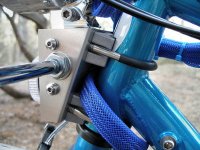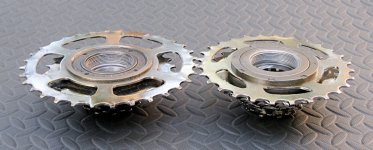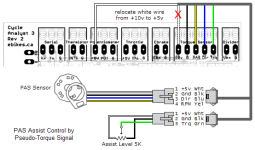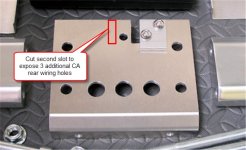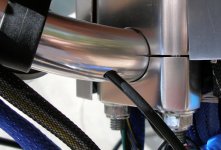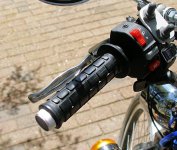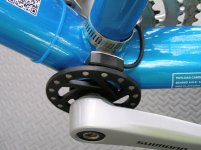GoPro Hero2 Camera Mount
A few posts back I ran down my quickie camera mount for a cheapie eBay camera. This really worked pretty well and my plan was to mod it slightly to accept a Hero2.
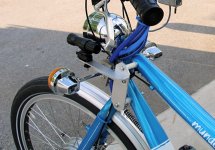
A little extender was fabbed to move the camera forward and extra spacers were added to get side clearance from the headlight for the Hero2, but the mount simply had too much flex. The heavier GoPro with the higher center of gravity applied more twist to the simple angle strut which did not have the torsional stability to hold the camera steady.
To solve the twist problem and reuse the old mount, two lengths of 10-32 threaded rod are threaded into it as fixed studs and tightened in place with acorn nuts. Some spacers (Ace Hardware) are used to clamp the edge of the extension firmly against the old mount. The spacers are actually a few thinner spacers stacked to get the exact inside height (7/8") of one leg of the angle used for the extender bar. This arrangement makes the new piece of angle stock somewhat more rigid like a channel. Some 10-32 theaded knobs (Ace Hardware) top the screw studs make the extension removable.
Unfortunately, to properly position the camera, the extender bar needs to be too long for the original rear-only mount to prevent side to side camera motion. A couple of bits of angle and rubber-lined steel cable clamps around the turn signal stalk solve the problem in a patchwork sort of way. The reworked 'old' mount is now rigid enough that a different extender could be fabbed to secure a fairly heavy camera. With the new cable clamps to reduce motion, the original rear vertical piece only needs to be wide enough to provide a mounting point, not stability. This will get trimmed down a bit as a winter project.

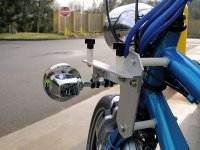
I found a nice little CNC aluminum tripod shoe for a standard GoPro mount on eBay for only $1.99 - the price seems to have gone up, but they work great. This is bolted up to the end of the extender bar with a 1/4-20 bolt (same as tripod screw).
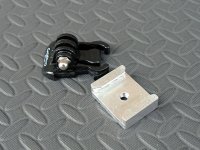
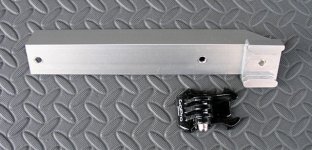
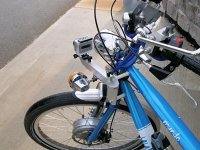
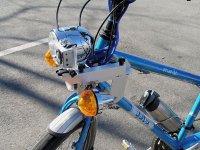
The final mount works great - no camera shake at all. With the Fat Franks to soak up small road irregularities, the videos are nice and smooth without post-processing stabilization. Got to post some vids! .
.
A few posts back I ran down my quickie camera mount for a cheapie eBay camera. This really worked pretty well and my plan was to mod it slightly to accept a Hero2.

A little extender was fabbed to move the camera forward and extra spacers were added to get side clearance from the headlight for the Hero2, but the mount simply had too much flex. The heavier GoPro with the higher center of gravity applied more twist to the simple angle strut which did not have the torsional stability to hold the camera steady.
To solve the twist problem and reuse the old mount, two lengths of 10-32 threaded rod are threaded into it as fixed studs and tightened in place with acorn nuts. Some spacers (Ace Hardware) are used to clamp the edge of the extension firmly against the old mount. The spacers are actually a few thinner spacers stacked to get the exact inside height (7/8") of one leg of the angle used for the extender bar. This arrangement makes the new piece of angle stock somewhat more rigid like a channel. Some 10-32 theaded knobs (Ace Hardware) top the screw studs make the extension removable.
Unfortunately, to properly position the camera, the extender bar needs to be too long for the original rear-only mount to prevent side to side camera motion. A couple of bits of angle and rubber-lined steel cable clamps around the turn signal stalk solve the problem in a patchwork sort of way. The reworked 'old' mount is now rigid enough that a different extender could be fabbed to secure a fairly heavy camera. With the new cable clamps to reduce motion, the original rear vertical piece only needs to be wide enough to provide a mounting point, not stability. This will get trimmed down a bit as a winter project.


I found a nice little CNC aluminum tripod shoe for a standard GoPro mount on eBay for only $1.99 - the price seems to have gone up, but they work great. This is bolted up to the end of the extender bar with a 1/4-20 bolt (same as tripod screw).




The final mount works great - no camera shake at all. With the Fat Franks to soak up small road irregularities, the videos are nice and smooth without post-processing stabilization. Got to post some vids!


